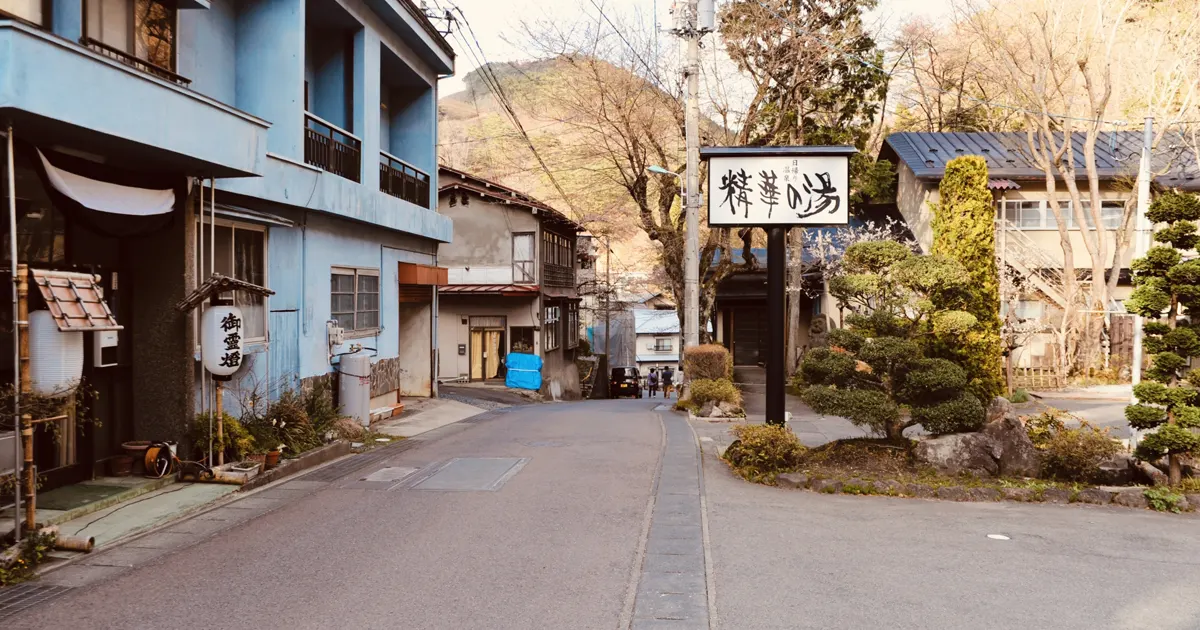Tucked away in the quiet mountain town of Hanamaki , Iwate, Dai Onsen is a nostalgic Japanese hot spring village lined with traditional wooden ryokans. The peaceful, steam-filled streets carry the scent of history, offering a warm welcome to every visitor. Just a short trip from Tokyo or Sendai brings you to a world wrapped in tranquil charm—that’s the beauty of Dai Onsen.
This article introduces everything you need to enjoy Dai Onsen, including how to get there, day trip tips, tattoo-friendly onsen inns, and how to avoid crowds. It’s designed to be especially helpful for solo travelers and first-time hot spring visitors.
If you’re looking for an off-the-beaten-path onsen in the Tohoku region, why not start a journey of quiet self-reflection here? Let’s explore the unique appeal of Dai Onsen.
Contents
Access to Dai Onsen: Train & Tips
Check the latest weather forecast before your visit: [weathernews ]
By Train
Tokyo Station
Take the Tohoku Shinkansen “Yamabiko” to Shin-Hanamaki Station (about 3 hours)
Transfer to the JR Kamaishi Line to Hanamaki Station (about 8 minutes)
From Hanamaki Station, take the Iwate Kotsu Bus to “Osawa Onsen Iriguchi” and walk about 5 minutes
Total travel time: Approximately 3 hours 30 minutes
Sendai Station
Take the Tohoku Shinkansen “Yamabiko” to Shin-Hanamaki Station (about 1 hour)
Transfer to the JR Kamaishi Line to Hanamaki Station (about 8 minutes)
From Hanamaki Station, take the Iwate Kotsu Bus to “Osawa Onsen Iriguchi” and walk about 5 minutes
Total travel time: Approximately 1 hour 30 minutes
Morioka Station
Take the JR Tohoku Main Line to Hanamaki Station (about 35 minutes)
From Hanamaki Station, take the Iwate Kotsu Bus to “Osawa Onsen Iriguchi” and walk about 5 minutes
Total travel time: Approximately 1 hour
One Point Advice
Visitor Info: Admission, Hours & Access
Admission: From 600 yen (varies by ryokan or onsen facility)
Hours: Varies by ryokan (generally 9:00–21:00)
Closed: Irregular holidays (check with each ryokan in advance)
Visit Hanamaki Official Website
Things to Do at Dai Onsen in Half a Day
Osawa Onsen Yujiraya|Historic Bathhouse Experience
This nostalgic inn , with over a century of history, features dark wooden corridors lit by bare bulbs, riverside open-air baths, and shared tatami lounges. Every corner radiates the warmth of old Japan. Both overnight stays and day-use bathing are available, providing a peaceful moment to reset your body and mind.Osawa Onsen Official Website
Duration: 1–1.5 hours
Admission: 700 yen (bath only)
Osawa Onsen Jisuibu|Stay Like a Local
Rather than just “visiting the bath,” here you can “live with the hot spring.” The self-catering style means guests use a shared kitchen, creating a community vibe reminiscent of the past. Long-term stays are common, and the experience of soaking in the same water each day gently loosens both body and spirit.Osawa Onsen Official Website
Duration: 1–2 hours (overnight stay recommended)
Admission: 700 yen (bath only); accommodation fees vary by ryokan
Kikusui-kan|Riverside Open-Air Onsen
Built right next to the river, this open-air Japanese bath feels like an extension of nature. In winter, guests soak in warmth while surrounded by snow and flowing water. It’s also available for day use and offers a truly luxurious way to spend time doing absolutely nothing but relaxing.Kikusui-kan Official Website
Duration: 30–40 minutes
Admission: 700 yen (bath only)
Nearby Places to Visit from Dai Onsen
Hanamaki Rose Garden|Easy Walk from Dai Onsen
Located about 20–25 minutes on foot from Dai Onsen , this rose garden blooms from spring through fall. It’s rarely crowded and perfect for a calm solo stroll. After soaking in the onsen, the combination of fresh air and floral scents provides a wonderful reset.
Kenji Miyazawa Museum|Literary Day Trip from Dai Onsen
From Hanamaki Station, take the JR Kamaishi Line to Shin-Hanamaki Station (about 8 minutes), then a bus for 10 minutes to reach this hilltop museum . Exhibits and videos explore the fantastical world of “Night on the Galactic Railroad.” It’s a great stop for travelers interested in literature or Japanese philosophy.Hanamaki Tourism Association Official Website
Oushuku Onsen|Peaceful Onsen Nearby for Next Day
About 60–70 minutes by train and bus from Dai Onsen, Oushuku Onsen offers a nostalgic atmosphere with Showa-era charm. Less touristy than major onsen resorts, it’s loved by locals and provides a gentle contrast to Dai Onsen’s serene mood—an ideal next destination.
Dai Onsen Travel FAQs
Can I visit Dai Onsen as a day trip?
It’s about 20 minutes by local bus from Hanamaki Station, and many ryokans offer day-use hot spring bathing.
Is Dai Onsen suitable for solo travelers?
Absolutely. Most inns accommodate solo guests, and the quiet surroundings make it easy to relax.
Are tattoos accepted at the baths?
Policies vary by ryokan, but some are tattoo-friendly. It’s best to check in advance.
Is it enjoyable even on rainy days?
Yes. Many inns have indoor lounges and cozy common areas with hearths, perfect for rainy weather.
When is the best time to avoid crowds?
Weekday mornings tend to be less busy. Weekends and holidays can get crowded, so visiting early is recommended.
Dai Onsen Summary|Plan Your Next Journey
Dai Onsen may not be flashy, but it offers something far deeper: genuine onsen culture and heartfelt hospitality. Wooden ryokans, riverside snow baths , and peaceful moments shared between travelers—this is where authentic Japan lives.
This article was crafted to help ease your travel concerns, from directions to local tips. If this sparked your curiosity, perhaps your next destination lies just beyond this peaceful valley.
Why not explore another corner of Hanamaki Onsen Village next?

